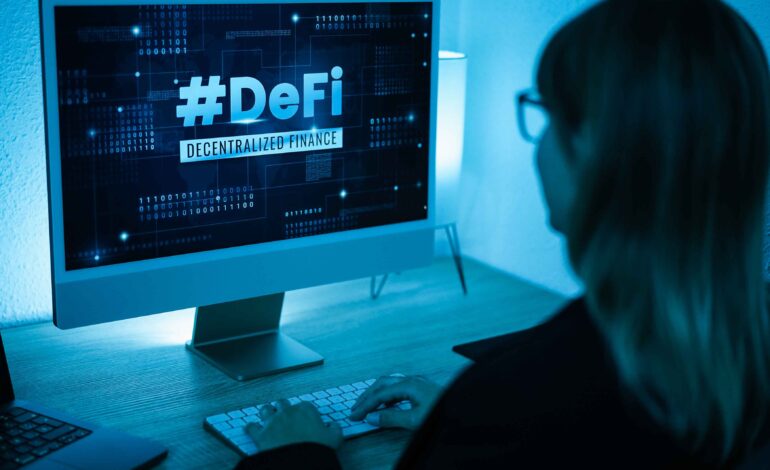💸 Introduction: Two Worlds, One Goal – Financial Access
Traditional finance, or “TradFi”.
On first glance, they may both look like they operate in separate universes — and in many regards, they do. Ultimately, both buildings will be attempting to solve the same problem: how people save, spend, borrow, and invest the money they have available to them.
The challenge is how they do it — and who dictates the power.
Let’s strip away the jargon and look at the real differences between DeFi and traditional finance.
🏦 What is Traditional Finance?
Traditional finance is what most of us grew up with — local bank, credit card companies, stock brokers – centralized finance with multiple institutions dictating decisions, access, and control. In some cases, many of these institutions have been around for over 100 years.
Need funds? You may need good credit along with a stable job, and you should also expect to fill out papers.
Want to invest? You may need to call a broker during trading hours, take time to get to know them, and pay some broker fees.
It’s a familiar, yet slow, closed-loop, and sometimes expensive process.
📌 Common Features of Traditional Finance:
-
Controlled access by banks and governments
-
Regulated by many strict laws (SEC, FCA, RBI…)
-
Many restrictions based on geography or identity
-
Credit system, stock markets, savings accounts, and generally insurance
🔗 DeFi: A Different Approach
DeFi does not rely on institutions. Instead, it uses blockchain technology, enabling direct user access and interaction to financial tools and services — without permissions, borders, or intermediaries.
Want to earn interest on your savings? You can do so in a few clicks through a DeFi protocol.
Want to swap tokens or take a loan? Connect your crypto wallet and it’s done.
It may sound risky — and in fact, in some cases, it is. But the shift in access to DeFi allows for people who were previously unbanked or underbanked to bypass traditional financial limitations.
🧠 What’s Different About DeFi:
-
Built on blockchain (ex: Ethereum, Solana, …)
-
No banks — only smart contracts running code
-
Accessible to anyone with an internet connection
-
Completely transparent and open 24/7
-
Users own their funds (no third party holds your assets)
⚖️ The Major Differences Between DeFi and Traditional Finance
| Aspect | Traditional Finance | DeFi |
|---|---|---|
| Control | By institutions (bank, government) | By users (wallet / smart contract) |
| Access | Depending on ID, credit, and location | Available to anyone with an internet connection |
| Intermediaries | Required (bank / broker) | None |
| Transparency | Opaque | Could be fully visible on the blockchain |
| Speed | Goes slowly (i.e., days to transfer) | Fast – minutes (or less) if the network isn’t busy |
| Fees | Varies, often hidden or high | Lower than traditional finance (but includes gas/network fees) |
| Hours | Business hours only | Every minute of every day of the year |
| Risk | Backed by legal systems and insurance | Software bugs, scams; no safety net |
| Regulation | Heavily regulated | Lightly or unregulated |
| Control of Assets | Third-party control (bank holds funds) | Self-custody and holds your keys |
🌍 User Experience: One is Safe, The Other is Sovereign
If you’ve been used to calling your bank when things go wrong, DeFi may feel like the Wild West.
But also, there’s freedom here. No waiting on wires to clear. No minimum balances. No frozen accounts because of “suspicious activity”.
DeFi reminds you that you are in charge — and with that comes some responsibility.
With DeFi, those barriers are lifted. If you have a smartphone and internet connection, you can access DeFi now.
This is a powerful financial inclusion tool for the 1.7 billion unbanked adults in the world.
📈 Investment Opportunities
Usually. Exciting? Not all the time.
DeFi offers:
-
Yield farming
-
Staking
-
Liquidity providing
-
Tokenized assets
-
Access to early-stage protocols
These tools may yield a higher risk, but also a potential higher reward.
⚖️ Regulation: Black and White vs. Grey
In traditional finance, regulation is easy.
Banks have clearly defined rules.
Customer deposits are insured.
Financial crime is monitored.
DeFi exists in a legal grey area. Some projects are entirely anonymous. Others are attempting to evade regulators by creating governance systems and KYC layers.
However, there is a freedom and flexibility to this unregulated basis, which can also result in scams, hacks, and exploits.
❓ So… Which is Better?
It depends on who you are, and what you want from your money.
-
If you seek safety, insurance, and structure, then traditional finance is still your best option.
-
If you seek control, innovation, and accessibility, then you can experiment with DeFi to achieve these benefits.
Most people to this day still embody both experiences. For example:
-
Saving money in a bank account but investing in DeFi tokens
-
Holding the cash you need day to day, while staking your crypto to earn passive income
A blended finance lifestyle is becoming more common — and perhaps, that is the future.





